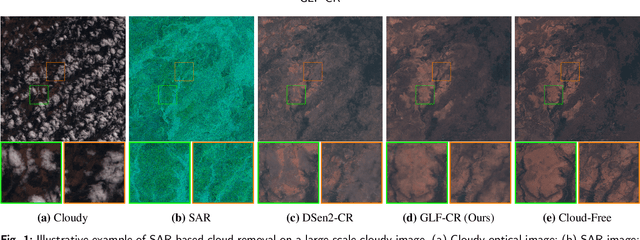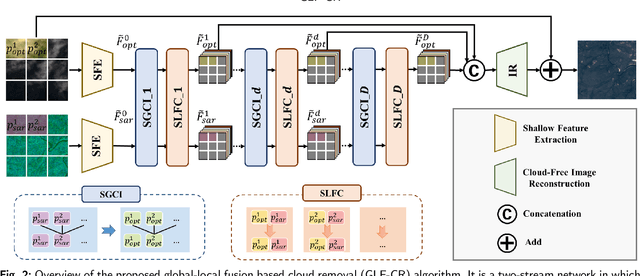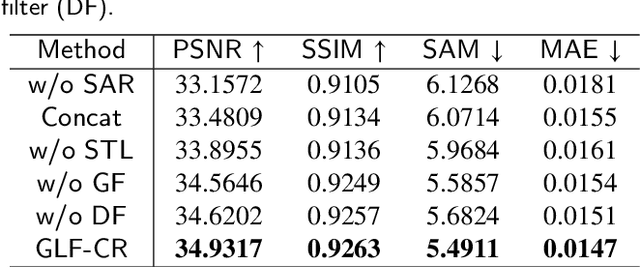Fang Xu
Mitigating the Impact of Prominent Position Shift in Drone-based RGBT Object Detection
Feb 13, 2025Abstract:Drone-based RGBT object detection plays a crucial role in many around-the-clock applications. However, real-world drone-viewed RGBT data suffers from the prominent position shift problem, i.e., the position of a tiny object differs greatly in different modalities. For instance, a slight deviation of a tiny object in the thermal modality will induce it to drift from the main body of itself in the RGB modality. Considering RGBT data are usually labeled on one modality (reference), this will cause the unlabeled modality (sensed) to lack accurate supervision signals and prevent the detector from learning a good representation. Moreover, the mismatch of the corresponding feature point between the modalities will make the fused features confusing for the detection head. In this paper, we propose to cast the cross-modality box shift issue as the label noise problem and address it on the fly via a novel Mean Teacher-based Cross-modality Box Correction head ensemble (CBC). In this way, the network can learn more informative representations for both modalities. Furthermore, to alleviate the feature map mismatch problem in RGBT fusion, we devise a Shifted Window-Based Cascaded Alignment (SWCA) module. SWCA mines long-range dependencies between the spatially unaligned features inside shifted windows and cascaded aligns the sensed features with the reference ones. Extensive experiments on two drone-based RGBT object detection datasets demonstrate that the correction results are both visually and quantitatively favorable, thereby improving the detection performance. In particular, our CBC module boosts the precision of the sensed modality ground truth by 25.52 aSim points. Overall, the proposed detector achieves an mAP_50 of 43.55 points on RGBTDronePerson and surpasses a state-of-the-art method by 8.6 mAP50 on a shift subset of DroneVehicle dataset. The code and data will be made publicly available.
Advancements in UAV-based Integrated Sensing and Communication: A Comprehensive Survey
Jan 11, 2025Abstract:Unmanned aerial vehicle (UAV)-based integrated sensing and communication (ISAC) systems are poised to revolutionize next-generation wireless networks by enabling simultaneous sensing and communication (S\&C). This survey comprehensively reviews UAV-ISAC systems, highlighting foundational concepts, key advancements, and future research directions. We explore recent advancements in UAV-based ISAC systems from various perspectives and objectives, including advanced channel estimation (CE), beam tracking, and system throughput optimization under joint sensing and communication S\&C constraints. Additionally, we examine weighted sum rate (WSR) and sensing trade-offs, delay and age of information (AoI) minimization, energy efficiency (EE), and security enhancement. These applications highlight the potential of UAV-based ISAC systems to improve spectrum utilization, enhance communication reliability, reduce latency, and optimize energy consumption across diverse domains, including smart cities, disaster relief, and defense operations. The survey also features summary tables for comparative analysis of existing methodologies, emphasizing performance, limitations, and effectiveness in addressing various challenges. By synthesizing recent advancements and identifying open research challenges, this survey aims to be a valuable resource for developing efficient, adaptive, and secure UAV-based ISAC systems.
Oriented Tiny Object Detection: A Dataset, Benchmark, and Dynamic Unbiased Learning
Dec 16, 2024Abstract:Detecting oriented tiny objects, which are limited in appearance information yet prevalent in real-world applications, remains an intricate and under-explored problem. To address this, we systemically introduce a new dataset, benchmark, and a dynamic coarse-to-fine learning scheme in this study. Our proposed dataset, AI-TOD-R, features the smallest object sizes among all oriented object detection datasets. Based on AI-TOD-R, we present a benchmark spanning a broad range of detection paradigms, including both fully-supervised and label-efficient approaches. Through investigation, we identify a learning bias presents across various learning pipelines: confident objects become increasingly confident, while vulnerable oriented tiny objects are further marginalized, hindering their detection performance. To mitigate this issue, we propose a Dynamic Coarse-to-Fine Learning (DCFL) scheme to achieve unbiased learning. DCFL dynamically updates prior positions to better align with the limited areas of oriented tiny objects, and it assigns samples in a way that balances both quantity and quality across different object shapes, thus mitigating biases in prior settings and sample selection. Extensive experiments across eight challenging object detection datasets demonstrate that DCFL achieves state-of-the-art accuracy, high efficiency, and remarkable versatility. The dataset, benchmark, and code are available at https://chasel-tsui.github.io/AI-TOD-R/.
Tiny Object Detection with Single Point Supervision
Dec 08, 2024



Abstract:Tiny objects, with their limited spatial resolution, often resemble point-like distributions. As a result, bounding box prediction using point-level supervision emerges as a natural and cost-effective alternative to traditional box-level supervision. However, the small scale and lack of distinctive features of tiny objects make point annotations prone to noise, posing significant hurdles for model robustness. To tackle these challenges, we propose Point Teacher--the first end-to-end point-supervised method for robust tiny object detection in aerial images. To handle label noise from scale ambiguity and location shifts in point annotations, Point Teacher employs the teacher-student architecture and decouples the learning into a two-phase denoising process. In this framework, the teacher network progressively denoises the pseudo boxes derived from noisy point annotations, guiding the student network's learning. Specifically, in the first phase, random masking of image regions facilitates regression learning, enabling the teacher to transform noisy point annotations into coarse pseudo boxes. In the second phase, these coarse pseudo boxes are refined using dynamic multiple instance learning, which adaptively selects the most reliable instance from dynamically constructed proposal bags around the coarse pseudo boxes. Extensive experiments on three tiny object datasets (i.e., AI-TOD-v2, SODA-A, and TinyPerson) validate the proposed method's effectiveness and robustness against point location shifts. Notably, relying solely on point supervision, our Point Teacher already shows comparable performance with box-supervised learning methods. Codes and models will be made publicly available.
Frequency-Adaptive Low-Latency Object Detection Using Events and Frames
Dec 05, 2024



Abstract:Fusing Events and RGB images for object detection leverages the robustness of Event cameras in adverse environments and the rich semantic information provided by RGB cameras. However, two critical mismatches: low-latency Events \textit{vs.}~high-latency RGB frames; temporally sparse labels in training \textit{vs.}~continuous flow in inference, significantly hinder the high-frequency fusion-based object detection. To address these challenges, we propose the \textbf{F}requency-\textbf{A}daptive Low-Latency \textbf{O}bject \textbf{D}etector (FAOD). FAOD aligns low-frequency RGB frames with high-frequency Events through an Align Module, which reinforces cross-modal style and spatial proximity to address the Event-RGB Mismatch. We further propose a training strategy, Time Shift, which enforces the module to align the prediction from temporally shifted Event-RGB pairs and their original representation, that is, consistent with Event-aligned annotations. This strategy enables the network to use high-frequency Event data as the primary reference while treating low-frequency RGB images as supplementary information, retaining the low-latency nature of the Event stream toward high-frequency detection. Furthermore, we observe that these corrected Event-RGB pairs demonstrate better generalization from low training frequency to higher inference frequencies compared to using Event data alone. Extensive experiments on the PKU-DAVIS-SOD and DSEC-Detection datasets demonstrate that our FAOD achieves SOTA performance. Specifically, in the PKU-DAVIS-SOD Dataset, FAOD achieves 9.8 points improvement in terms of the mAP in fully paired Event-RGB data with only a quarter of the parameters compared to SODFormer, and even maintains robust performance (only a 3 points drop in mAP) under 80$\times$ Event-RGB frequency mismatch.
LaVIDE: A Language-Vision Discriminator for Detecting Changes in Satellite Image with Map References
Nov 29, 2024Abstract:Change detection, which typically relies on the comparison of bi-temporal images, is significantly hindered when only a single image is available. Comparing a single image with an existing map, such as OpenStreetMap, which is continuously updated through crowd-sourcing, offers a viable solution to this challenge. Unlike images that carry low-level visual details of ground objects, maps convey high-level categorical information. This discrepancy in abstraction levels complicates the alignment and comparison of the two data types. In this paper, we propose a \textbf{La}nguage-\textbf{VI}sion \textbf{D}iscriminator for d\textbf{E}tecting changes in satellite image with map references, namely \ours{}, which leverages language to bridge the information gap between maps and images. Specifically, \ours{} formulates change detection as the problem of ``{\textit Does the pixel belong to [class]?}'', aligning maps and images within the feature space of the language-vision model to associate high-level map categories with low-level image details. Moreover, we build a mixture-of-experts discriminative module, which compares linguistic features from maps with visual features from images across various semantic perspectives, achieving comprehensive semantic comparison for change detection. Extensive evaluation on four benchmark datasets demonstrates that \ours{} can effectively detect changes in satellite image with map references, outperforming state-of-the-art change detection algorithms, e.g., with gains of about $13.8$\% on the DynamicEarthNet dataset and $4.3$\% on the SECOND dataset.
NeuroFly: A framework for whole-brain single neuron reconstruction
Nov 07, 2024



Abstract:Neurons, with their elongated, tree-like dendritic and axonal structures, enable efficient signal integration and long-range communication across brain regions. By reconstructing individual neurons' morphology, we can gain valuable insights into brain connectivity, revealing the structure basis of cognition, movement, and perception. Despite the accumulation of extensive 3D microscopic imaging data, progress has been considerably hindered by the absence of automated tools to streamline this process. Here we introduce NeuroFly, a validated framework for large-scale automatic single neuron reconstruction. This framework breaks down the process into three distinct stages: segmentation, connection, and proofreading. In the segmentation stage, we perform automatic segmentation followed by skeletonization to generate over-segmented neuronal fragments without branches. During the connection stage, we use a 3D image-based path following approach to extend each fragment and connect it with other fragments of the same neuron. Finally, human annotators are required only to proofread the few unresolved positions. The first two stages of our process are clearly defined computer vision problems, and we have trained robust baseline models to solve them. We validated NeuroFly's efficiency using in-house datasets that include a variety of challenging scenarios, such as dense arborizations, weak axons, images with contamination. We will release the datasets along with a suite of visualization and annotation tools for better reproducibility. Our goal is to foster collaboration among researchers to address the neuron reconstruction challenge, ultimately accelerating advancements in neuroscience research. The dataset and code are available at https://github.com/beanli161514/neurofly
Rethinking Scale Imbalance in Semi-supervised Object Detection for Aerial Images
Oct 23, 2023



Abstract:This paper focuses on the scale imbalance problem of semi-supervised object detection(SSOD) in aerial images. Compared to natural images, objects in aerial images show smaller sizes and larger quantities per image, increasing the difficulty of manual annotation. Meanwhile, the advanced SSOD technique can train superior detectors by leveraging limited labeled data and massive unlabeled data, saving annotation costs. However, as an understudied task in aerial images, SSOD suffers from a drastic performance drop when facing a large proportion of small objects. By analyzing the predictions between small and large objects, we identify three imbalance issues caused by the scale bias, i.e., pseudo-label imbalance, label assignment imbalance, and negative learning imbalance. To tackle these issues, we propose a novel Scale-discriminative Semi-Supervised Object Detection (S^3OD) learning pipeline for aerial images. In our S^3OD, three key components, Size-aware Adaptive Thresholding (SAT), Size-rebalanced Label Assignment (SLA), and Teacher-guided Negative Learning (TNL), are proposed to warrant scale unbiased learning. Specifically, SAT adaptively selects appropriate thresholds to filter pseudo-labels for objects at different scales. SLA balances positive samples of objects at different scales through resampling and reweighting. TNL alleviates the imbalance in negative samples by leveraging information generated by a teacher model. Extensive experiments conducted on the DOTA-v1.5 benchmark demonstrate the superiority of our proposed methods over state-of-the-art competitors. Codes will be released soon.
High-Resolution Cloud Removal with Multi-Modal and Multi-Resolution Data Fusion: A New Baseline and Benchmark
Jan 09, 2023



Abstract:In this paper, we introduce Planet-CR, a benchmark dataset for high-resolution cloud removal with multi-modal and multi-resolution data fusion. Planet-CR is the first public dataset for cloud removal to feature globally sampled high resolution optical observations, in combination with paired radar measurements as well as pixel-level land cover annotations. It provides solid basis for exhaustive evaluation in terms of generating visually pleasing textures and semantically meaningful structures. With this dataset, we consider the problem of cloud removal in high resolution optical remote sensing imagery by integrating multi-modal and multi-resolution information. Existing multi-modal data fusion based methods, which assume the image pairs are aligned pixel-to-pixel, are hence not appropriate for this problem. To this end, we design a new baseline named Align-CR to perform the low-resolution SAR image guided high-resolution optical image cloud removal. It implicitly aligns the multi-modal and multi-resolution data during the reconstruction process to promote the cloud removal performance. The experimental results demonstrate that the proposed Align-CR method gives the best performance in both visual recovery quality and semantic recovery quality. The project is available at https://github.com/zhu-xlab/Planet-CR, and hope this will inspire future research.
Exploring the Potential of SAR Data for Cloud Removal in Optical Satellite Imagery
Jun 06, 2022



Abstract:The challenge of the cloud removal task can be alleviated with the aid of Synthetic Aperture Radar (SAR) images that can penetrate cloud cover. However, the large domain gap between optical and SAR images as well as the severe speckle noise of SAR images may cause significant interference in SAR-based cloud removal, resulting in performance degeneration. In this paper, we propose a novel global-local fusion based cloud removal (GLF-CR) algorithm to leverage the complementary information embedded in SAR images. Exploiting the power of SAR information to promote cloud removal entails two aspects. The first, global fusion, guides the relationship among all local optical windows to maintain the structure of the recovered region consistent with the remaining cloud-free regions. The second, local fusion, transfers complementary information embedded in the SAR image that corresponds to cloudy areas to generate reliable texture details of the missing regions, and uses dynamic filtering to alleviate the performance degradation caused by speckle noise. Extensive evaluation demonstrates that the proposed algorithm can yield high quality cloud-free images and performs favorably against state-of-the-art cloud removal algorithms.
 Add to Chrome
Add to Chrome Add to Firefox
Add to Firefox Add to Edge
Add to Edge